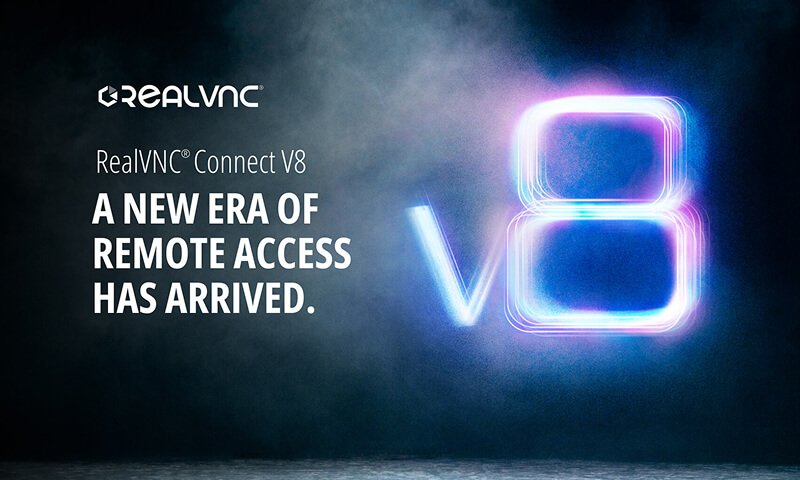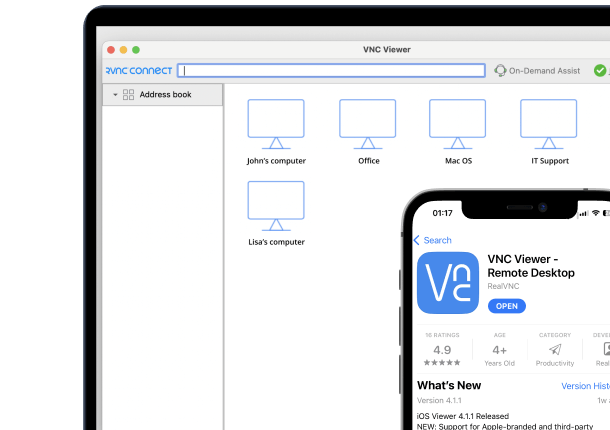Remember when visiting the doctor meant sitting in a waiting room, flipping through old magazines? Thankfully, those days are fading fast. Digital transformation in healthcare has turned clinics into connected hubs buzzing with technology, making life better for both healthcare professionals and their patients.
While we might not have reached the shiny gadgets of a sci-fi med bay just yet, this digital transformation is already delivering smarter, faster, and more professional care.
In this article, we explore what’s driving these digital transformation initiatives and address the bumps that have come up along the way. We’ll also highlight the crucial role secure remote access tools like RealVNC Connect are helping the teams that support and manage these vital digital health systems.
What Exactly Is Digital Transformation in Healthcare?
Digital transformation simply means integrating digital technologies into every part of our healthcare system. Think of it as healthcare’s equivalent of upgrading from slow old dial-up internet to lightning-fast fiber optics. Once you’ve experienced it, there’s no going back (and nor would you want to).
These technologies in healthcare cover everything from electronic health records (EHRs) that thankfully make doctors’ handwriting obsolete, to telehealth appointments that bring high-quality care to even the most remote locations.
However, it’s not just digital charts and virtual visits. It’s also IoT devices, like smart wearables that track heart rate and blood sugar and alert your doctor before you even know something is off. Then there are cloud-based platforms that make sure your health information is securely accessible exactly when it’s needed most.
This tech revolution is convenient, but it also significantly improves patient outcomes, widens health equity, and makes services far more efficient. Even the World Health Organization’s digital health guidelines now strongly encourage adopting these digital interventions across the board.
Why Are Health Systems Accelerating Digital Transformation?
If there’s one thing certain about modern health systems, it’s that they’re feeling the pressure to evolve, and fast. No patient today wants to sit in traffic for hours for a ten-minute appointment, and if we’re honest, neither do their doctors. This and the nearly 3800% surge in telehealth adoption due to the COVID-19 pandemic have made telemedicine and remote care services essential.
Beyond convenience, health organizations are practically swimming in data. Without effective management and interoperability, they risk drowning in it. Emerging technologies are powerful enough to sift through mountains of health information and spot patterns that humans might otherwise miss.
Even emergency response teams and paramedics are benefiting. Having secure remote access to patients’ medical histories rather than relying on information at the scene is literally saving lives.
Finally, there’s good old-fashioned regulatory pressure pushing these digital transformation initiatives forward. Compliance standards like HIPAA (Health Insurance Portability and Accountability Act) mean healthcare providers must modernize quickly or risk fines and reputational damage.
The Real Benefits of Digital Health for Healthcare Professionals
Everyone loves a good upgrade, and digital health is delivering that in spades for healthcare professionals everywhere. Here’s what’s in it for you and your patients:
- Personalized care: With rich patient data at their fingertips, providers can customize treatments for individuals and significantly improve patient care outcomes.
- Operational efficiency: Streamlined workflows through digital platforms mean less time is wasted chasing down paperwork and more time is available to help patients.
- Reducing costs: Investments in digital tools are economically smart. Recent studies from the National Bureau of Economic Research indicate that leveraging AI and advanced analytics could save health services a staggering $200 to $360 billion annually.
- Collaboration made easy: When platforms are centralized, communication between medical teams becomes faster. This minimizes miscommunications, and mix-ups, and spares everyone from having to decipher handwritten prescriptions.
- Extended reach: Digital solutions make sure that quality healthcare reaches even the most remote or underserved communities. This levels the playing field and delivers better health equity.
Core Technologies Driving Digital Healthcare Forward
There are some seriously impressive technologies pushing digital transformation into the healthcare sector. Let’s look at the biggest ones being implemented right now:
- Telemedicine platforms: Virtual consultations and remote monitoring have exploded in popularity thanks to top telehealth services like Amwell, MDLIVE, and Teladoc Health. Goodbye crowded waiting rooms, hello convenience.
- Electronic Health Records (EHRs): Centralized EHR systems and digital strategy are quickly becoming commonplace across the U.S. In fact, Grand View Research has indicated that adoption rates have soared across all 50 states as healthcare moves toward more integrated operations.
- Medical IoT: The ‘Medical Internet of Things’ has entered the exam room (and even your bloodstream) with connected medical devices. Smart implants and wearables now deliver real-time healthcare data, enabling more proactive care.
- Advanced analytics: Powerful tools like Google Health and Alteryx bring sophisticated data-driven decision-making and predictive analytics directly to clinicians. This significantly improves clinical decision-making and helps doctors stay well ahead of potential health issues.
- Secure remote access: RealVNC Connect offers remote medical device access and management. This way, nurses and medical staff can check patient information and vitals and perform data entry from anywhere in the hospital using a laptop or tablet.
The Role of Secure Remote Access in Digital Healthcare
Ever had to wait for IT to physically arrive while systems are down? Not only is it about as pleasant as watching paint dry, but in the healthcare sector where every minute counts, it could cost lives.
Secure remote access is an essential part of modern healthcare organizations. It allows IT teams to manage, monitor, and troubleshoot systems quickly and without sprinting through hospital corridors.
Digital tools for secure remote access, such as RealVNC Connect, enable encrypted, HIPAA-compliant, and permission-based remote connections to servers and administrative systems. This means that all your healthcare data stays safe and locked tighter than a pharmacy supply cabinet.
Clinicians benefit too. Picture a doctor accessing a patient’s latest radiological images straight from their iPad, securely, from any corner of the hospital. This cross-platform compatibility means a unified experience whether they’re using Windows, Mac, Linux, iOS or Android.
The result is dramatically improved operational efficiency for healthcare providers, fewer delays in healthcare, and serious cost savings.
Challenges That Healthcare Organizations Face During Digital Transformation
If digital transformation were as simple as taking a patient’s temperature, everyone would have nailed it by now. Unfortunately, healthcare organizations often find themselves stumbling through a few hurdles. Here are the most common issues:
- Security and privacy: Protecting patient healthcare data is obviously paramount. With cyber attacks increasingly targeting the healthcare sector, making sure that robust security standards like HIPAA in the U.S. and GDPR in Europe are in place is essential.
- Costs and budgets: Digital upgrades don’t come cheap. There’s the initial tech investment, plus ongoing maintenance costs. And as budgets tighten, convincing executives and boards to allocate resources might prove challenging.
- Interoperability: Getting legacy medical systems to talk to newer technology is tough. Effective digital transformation demands interoperability at multiple levels. According to the HIMSS, this means addressing interoperability at foundational, structural, semantic, and organizational levels.
- Digital literacy gaps: Medical professionals are good at what they do, but that doesn’t automatically mean they’re experts at tech, either. Digital literacy gaps can mean staff members struggle with basic digital tasks such as data entry, and patients struggle to access patient portals. Customer training is one of the best ways to mitigate this challenge.
- Change management: One of the biggest challenges is very human—resistance to change. Changing existing workflows and entrenched organizational structures is very real, and convincing teams to embrace these new processes will be tough.
Navigating Change Management to Successfully Implement Digital Health
Image: Unsplash | Alt-text: Sticky notes on a corkboard
Adopting digital transformation in healthcare relies heavily on great tech. It also takes deliberate and well-planned change management. Here’s what organizations should be prioritizing:
- Invest in security first: Make cybersecurity, access control, and data protection the foundation on which you build your strategy.
- Train the talent pool: Build a digital mindset across all staff levels with regular, role-relevant training.
- Pick the right tools: Choose digital tools that are user-friendly and interoperable with your current systems and medical devices.
- Lean on cross-functional teams: Encourage collaboration between IT, clinical, and administrative departments to break down silos and get everyone on the same page.
- Install robust remote access: Use secure remote access tools like RealVNC Connect for remote support to reduce on-site IT burdens, especially across multiple locations.
Future Trends Shaping Digital Healthcare
The future of healthcare is increasingly digital. It’s also looking smarter, faster, and more connected than ever. Several key trends are set to redefine how care is delivered and experienced:
Artificial intelligence has moved past the buzzword stage and into real-world diagnostics. With AI and RealVNC Connect, the future is already here. One healthcare company uses AI to analyze medical imaging, delivering faster, more precise diagnoses. The client also uses RealVNC Connect to maintain secure, real-time access across systems while meeting strict compliance standards.
Expect broader use of telehealth and IoT tools to manage chronic diseases and improve population health, especially in underserved areas where consistent in-person care isn’t always feasible.
Meanwhile, AR and VR technologies will revolutionize clinical training, helping staff sharpen skills in simulated environments before being applied to real-world scenarios.
Getting Started: Implementing Your Healthcare Digital Strategy
Ready to bring your digital and organizational strategy to life? Here’s a practical starting point for healthcare sector leaders:
- Assess your digital maturity: Identify any current gaps in tech, workflows, and training.
- Align with your organizational strategy: Make sure that your plan supports both clinical goals and long-term business objectives.
- Focus on the fundamentals: Prioritize security, compliance, interoperability, and timely access to accurate patient information.
- Involve everyone: Engage with healthcare professionals early on. Successful digital adoption depends on their input and buy-in.
- Build with remote access in mind: Make tools like RealVNC Connect a part of your digital strategy to maintain flexible infrastructure and provide support to your entire system.
Embracing the Digital Future of Health Care
For healthcare organizations, digital transformation in healthcare is no longer a future goal. It’s something to prioritize today. From smarter use of healthcare data to more connected systems, the path forward leads to more high-quality care and stronger patient experiences.
However, none of it works without secure, reliable infrastructure.
Ready to modernize your healthcare delivery? Get started with RealVNC Connect today.
FAQs: Digital Transformation in Healthcare
What does digital transformation mean in healthcare?
It’s about using modern tech to improve how care is delivered, managed, and experienced by both patients and staff.
What are the main areas of digital transformation in healthcare?
Think telehealth, electronic records, remote monitoring, data tools, and smarter workflows behind the scenes.
What are the key pillars of digital transformation in healthcare?
Strong leadership, secure tech, easy-to-use tools, and getting everyone on board from nurses to IT.
How is digital technology changing healthcare?
They’re making care faster, more accurate, and easier to access, whether you’re in a hospital or at home.
Why is digital transformation important in healthcare?
Because better tools mean better care. It helps patients get what they need, when they need it, with less hassle.







